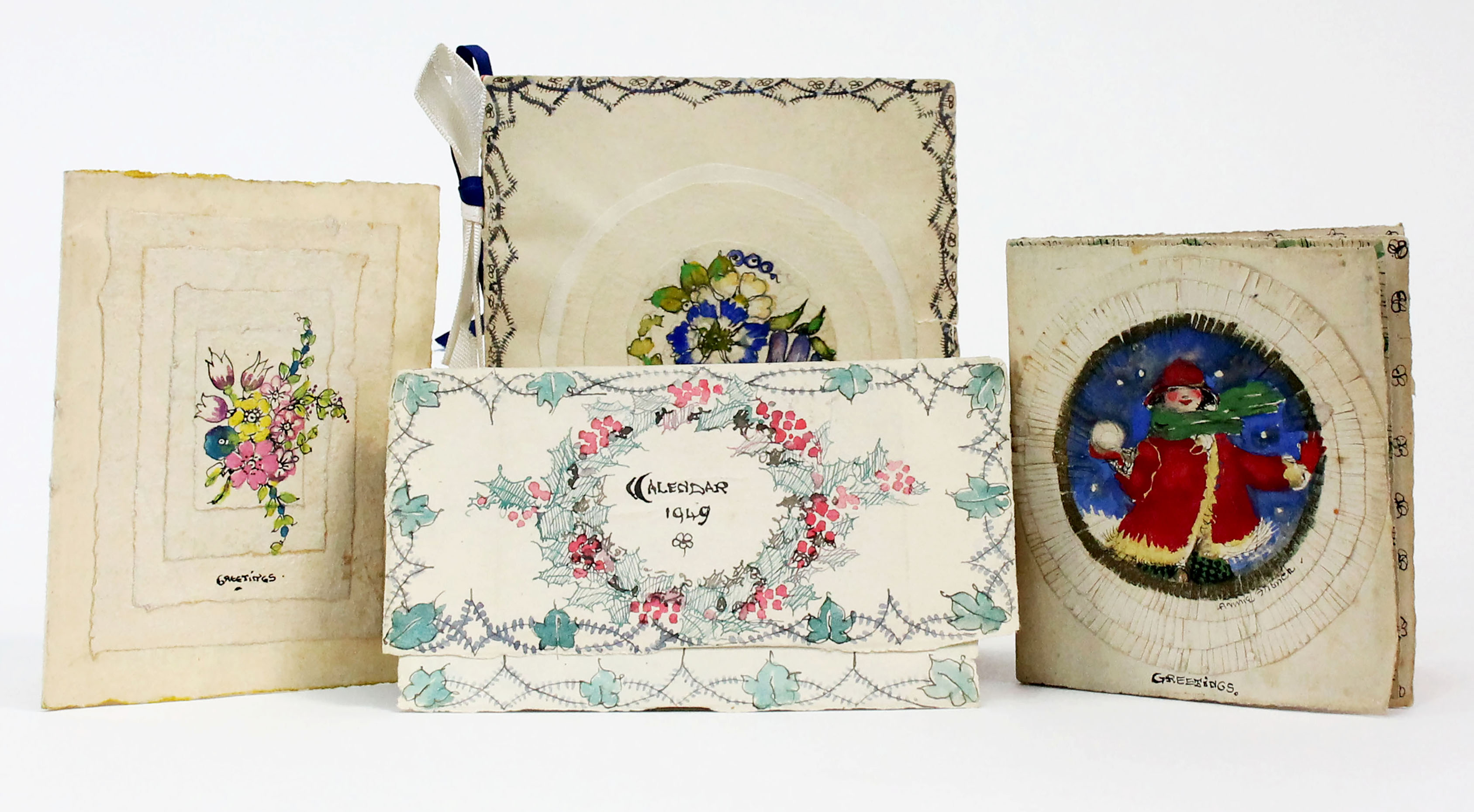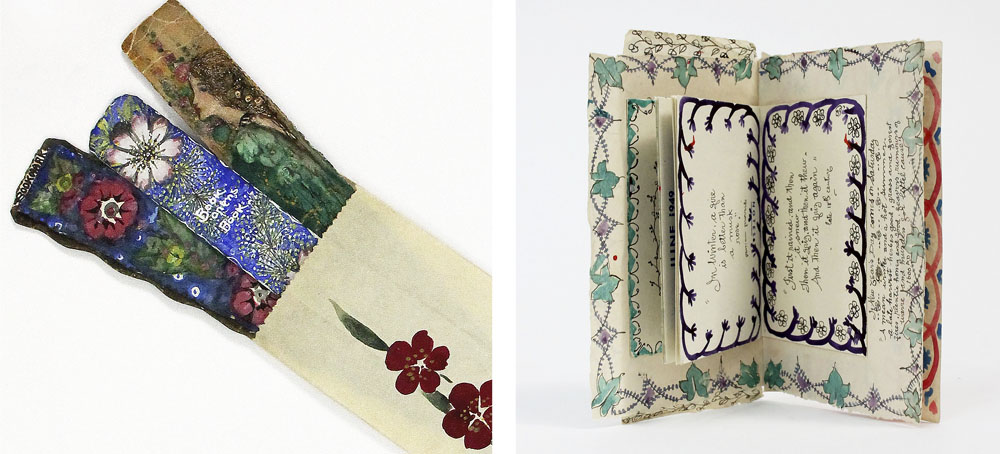A Beautiful Annie French Collection

Annie French’s letters to Violet Neith
Over the last few days I have had the pleasure of researching and cataloguing a collection of decorated letters, calendars, and bookmarks created by the “Glasgow Girl” and contemporary of Jessie M. King, Annie French, which has been a lovely task while working from home! Annie French (born 1872) is something of an elusive figure and little is recorded of her life, which makes these letters and keepsakes that she made for a close friend very special.
The calendars and letters are decorated with tiny detailed borders and flowers which have a certain looseness of style that lends them a frothy romanticism. French also often adds profuse collections of her favourite quotations in beautiful lettering. The colourful bookmarks are covered in colourful flowers, and one of them bears the image of an enchanting young woman with long hair and a flowing green gown.
The letters and gifts date between 1939 and 1954, each sent as “New Year Greetings”. The recipient is Violet Neith (née Anderson) of the artistic Anderson family. Violet’s mother and father, Daisy Agnes McGlashan and William Smith Anderson, met at the Glasgow School of Art, and attended the school at the same time as Annie French, which is likely to be how the families became friends. Violet and her sister Daisy (in the letters French affectionately enquires after “the Daisies”, clearly referring to Violet’s mother and sister) also attended the school in the 1920s. French also mentions handmade art and gifts that she had received herself from Violet, Violet’s artist husband John Neith, as well as more of their friends and family; you really get a sense of the creative energy in the social and family groups that were affiliated with the “Glasgow School”, even decades after the movement’s greatest peak in fame and success.

Calendars made by Annie French
It is difficult to build a complete picture of French’s life. Much of what is known is owed to the research of the art dealer Una Rota, who was unfortunately unable to complete her planned biography of French due to ill health in her later years. Much of Rota’s research consists of correspondence with people who knew French, leading more to a picture of her as a person rather than the historical structure of her life events. One lovely quote from a friend of French describes her as “like thistle down, she was small, dainty and merry”. It is believed that French, in something of an artistic tradition, destroyed many of her own papers at the end of her life (in one of the letters, French describes returning gifts given to her by her friends to them, for fear of their artwork being snatched into the unknown in the event of her own death), so it is wonderful to see these letters which have clearly been carefully cherished for many years by Violet Neith. The letters mostly detail small comments on and descriptions of everyday life, but French’s creative and adept use of language make them a compelling read, with metaphors like “butterfly” people, and not caring for a life that is a “stream that tumbled along among boulders”.

The bookmarks in their decorated envelope and the inside of one of the calendars
After her studies, French returned to The Glasgow School of Art as a teacher, before marrying a fellow artist, George Woolliscroft Rhead, with whom she moved to London in 1914. Some time after George’s death in 1920 French moved to “1 Oaklands” in Kenley, Surrey, where she lived, seemingly across two flats, with two of her sisters, Agnes and Margaret, and this is where this collection was created. Agnes died in 1952, and Margaret suffered an unnamed accident from which she unfortunately never recovered, dying in 1954. There are various points in the letters in which French describes finding life difficult, and it is surely these events to which she refers. It has previously been suggested that French then moved to Jersey to live near to relatives as a reaction to both sisters’ deaths, but these letters reveal that Annie and Margaret were both planning on the move: French describes trying to get her affairs and belongings in order, and says that Margaret will need to recover before the move.
French did eventually move to Jersey to be close to her sister-in-law and beloved nephew Eric, who enjoyed painting with his aunt, and whose recollections of her form some of the most intimate components of Rota’s research. French died in Jersey in 1965 at the grand age of 92. These beautiful gifts and letters offer a remarkable and truly unique look into the work and life of a private, and in my opinion unfortunately overlooked, artist, as well as a small snippet of the wider, vibrant world of the Glasgow School, which so influentially shaped British decorative arts at the birth of the 20th century.
Comments - One Response to “A Beautiful Annie French Collection”
Leave a Reply


I stumbled upon this lovely article whilst looking for books relating to Annie French. Annie was my great great Aunt, my mother was close to her and also attended Glasgow School of Art. She has such fond memories of her and their time together, she has the only known painting of Auntie Annie currently hanging on the wall of her sitting room, alongside the portraits of Annie’s brother James (my Great Grandfather) and his wife Jasmine, who moved to Jersey after his death, my Mother spent many happy summers with Gigi and uncle Eric.
If you would like any more information, I am sure my mother would be more than happy to share her memories.
Very best regards
Dee